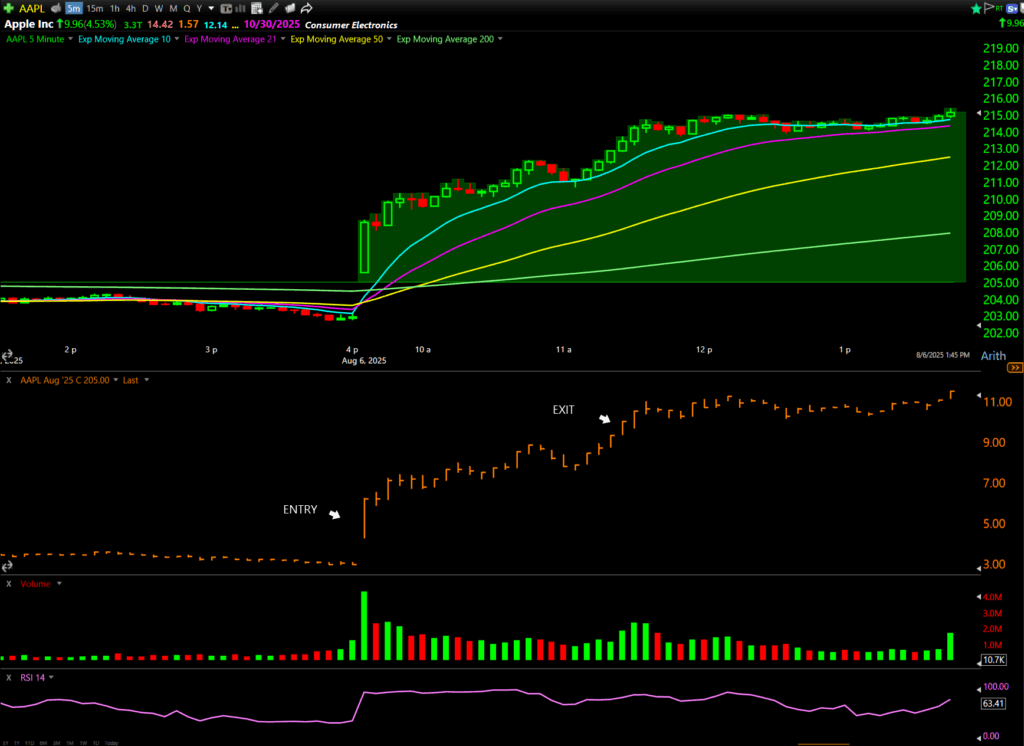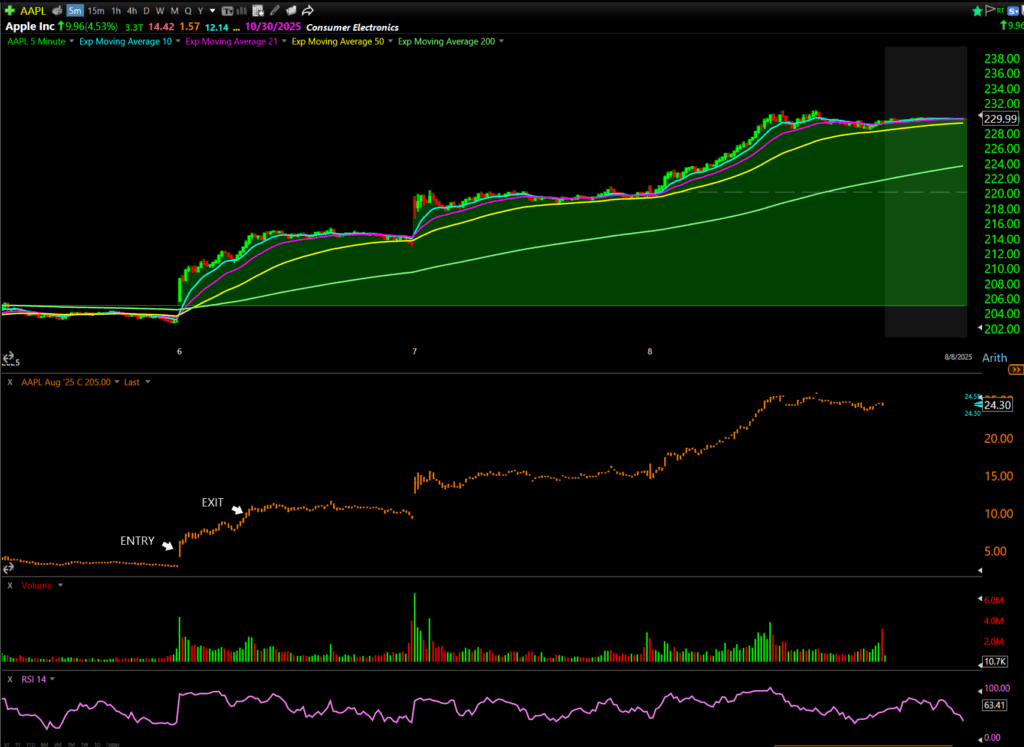Good morning, traders…
Picture this: You’re in a trade and you’re in the green…
…you have a feeling that the chart pattern could continue in your favor, but you’re also tempted to take the money and run…
…the end of the trading day is getting close, and you need to make a tough decision…
To hold or not to hold?
Holding vs. not holding is one of the most difficult decisions traders have to make. Every great trader has debated this question at one point or another.
Sure, more than half of the battle is finding these excellent setups and entering at the right price point…
But if you don’t exit the trade correctly, all of the work you did to research the play will have been for nothing.
This is especially true if you’re day trading weekly options, where a green trade can go red in mere minutes.
Let’s Compare The Pros And Cons Of Holding Runners Vs. Booking Profits. We’ll Figure Out Which Move Is Right For You Together…
Alex’s Tough Call
My friend (we’ll call him Alex) recently came to me with a dilemma that plagues every trader at one point or another.
First, he told me he’s been making excellent trades recently, with an 80% win rate over the past three months.
Sounds great, right?
What’s the problem, you ask?
He’s been selling too early, leaving money on the table, and foregoing account-changing gains in the process…
He told me about a particularly painful situation he faced trading Apple Inc. (NASDAQ: AAPL) last week.
On August 6, Alex bought AAPL AUGUST 15 $205 Calls @ $5.22
The trade worked immediately.
AAPL was surfing the 10-day exponential moving average on the 5-minute chart, and Alex was stacking some impressive gains.
Less than two hours after entry, he decided to sell all of his contracts at $9.81 for an intraday gain of 118%:

Great trade, right? Alex agreed. At the time, he was happy with the results.
But then, the pain began…
AAPL proceeded to surge unstoppably for the next two trading days, with the underlying stock gaining more than 8.5% following his exit (and before his contracts expired):

Meanwhile, the calls he had exited went absolutely parabolic…
The calls he exited at $9.60 ultimately traded as high as $25 (!!!) by Friday afternoon.
In other words, Alex 2x’d his initial investment — but missed out on a potential 300% home run.
What would you have done in this situation? Do you take the money and run, or hold when the chart looks strong?
The truth is, there’s no one correct answer for every potential setup, but there are certain things to look for that can help you make this call…
A Win is a Win
If you have a clear price target before entering, and then hit it, you should be perfectly comfortable exiting.
That’s why you make a trading plan in the first place: to follow it.
That’s why you pick a price target: to know where to sell.
But I get it. Even if you were happy with your exit, it’s natural to kick yourself if the trade keeps running after you sell.
That’s human nature, but those emotions are a dangerous trap.
Learn to be happy with executing on your plan. A win is a win, especially a 100% intraday banger (like Alex’s).
But in that rare situation where every signal is telling you to hold, consider the following:
4 Crucial Considerations for Exiting Trades
You don’t have to sell all of your contracts at once
If you follow my trading alerts, you’ll notice that I always scale out of my initial position into strength.
This allows me to take some risk off the table and lock up safe profits while still having some skin in the game.
Don’t think you have to enter and exit the entirety of your position at one time.
If you aren’t already, start scaling out.
Up 100%? Sell half of your position…
If you’re up 100% on an options trade — but think it might go even further — you can sell half of your position to make the remainder of the trade ‘risk-free.’
From there, you’re ‘playing with house money’ because you’ve locked up your initial investment.
This can make the second half of the trade — and your ultimate exit — much less stressful.
Plus, you’ll still have some ‘risk-free’ exposure if the stock continues in your direction over the following days.
Always know your price target (and your risk level)
You should always have a price target where you plan to exit … before you enter the trade.
I like to have a target for the share price as well as for the options premium.
For example, I’ll write in my trading journal “I’m aiming for Stock XYZ to hit $95, or to hold the contracts until $1.20.”
I also include my stop loss — and stick to it.
What’s the broader market doing?
If you see the decision as a true 50/50 coin toss, it’s time to look to the overall market for some clues.
If the major indexes are moving in the opposite direction of your position, you might lean towards taking the money and running.
But if the broader market is moving in the same direction as your contracts, you need to consider that when making your decision.
Additionally, consult the Volatility Index (VIX). If you’re holding calls and the VIX is above $13, lean towards selling.
But if it’s under $13, that means there’s low volatility, which could work in your call options’ favor.
A Simple Question
To summarize, in these scenarios, you have two choices:
- Sell it all — Be greedy with your gains … Take the money and run.
- Sell some of your position — But hold the rest overnight for a potential home run.
- Hold it all.
90% of the time, I recommend option A or B. In general, it’s best to lock in profits on your winning trades before they evaporate.
That said, it’s moments like these where the art of technical analysis comes into focus.
If you’ve studied chart patterns as much as I have, you may be able to pick out the rare, overnight-hold, grand-slam winner.
10% of the time, you need the guts to go with option B or C. Those rare holds could be the difference between a garden-variety win and an account-changing windfall.
Having the conviction to hold a winner isn’t easy. But missing that once-in-a-year grand slam is almost as bad as losing money. Keyword: almost.
Ultimately, no one can make these kinds of trading decisions for you. The correct choice depends on your individual personality and risk tolerance.
But next time you’re faced with such a decision, there’s a simple trick to give yourself a quick litmus test.
Ask yourself, what would bother you more?
- Selling your contracts, only for the stock to move higher, and miss the grand slam?
Or…
- Holding too long, only for the stock to reverse lower, and watching your hard-fought, unrealized gains disappear?
Your answer will tell you how to proceed.
Happy trading,
Ben Sturgill
P.S. Want to learn how to execute trades like this?*
The best place to start is in our Smart Money Workshops.
Stop missing the best setups in the options market.
Join our workshop TODAY at 2:00 p.m. EST.
The opportunity is yours. You just have to take it.
*Past performance does not indicate future results



